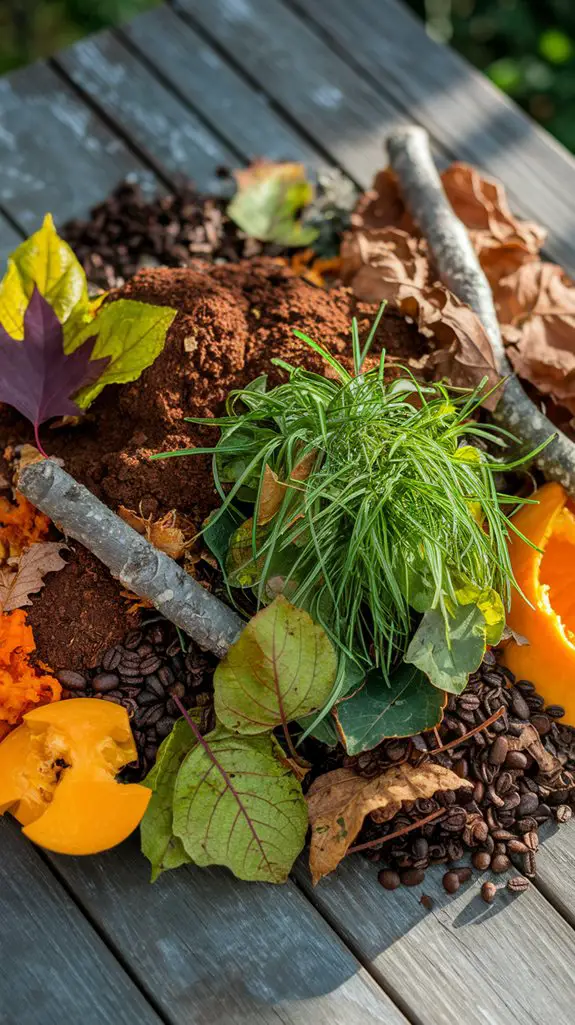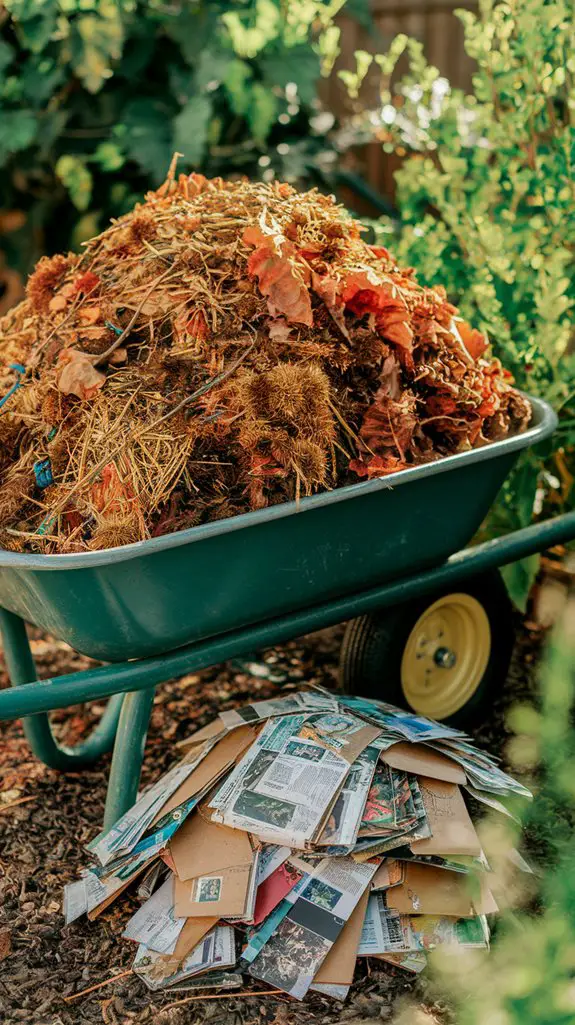Creating a thriving compost system depends entirely on your material selection. You’ll need to balance nitrogen-rich “greens” with carbon-rich “browns” at roughly a 1:3 ratio to achieve ideal decomposition. Kitchen scraps like vegetable peels and coffee grounds provide essential nitrogen, while fall leaves and cardboard deliver necessary carbon. The specific materials you choose will determine not only your compost’s nutrient profile but also how quickly it transforms into that dark, crumbly soil amendment your garden craves.
Essential Kitchen Scraps for Nutrient-Rich Compost
When selecting kitchen scraps for composting, prioritize nitrogen-rich materials that accelerate decomposition and enhance nutrient content.
Fruit and vegetable peels contribute essential micronutrients while coffee grounds (pH 6.5-6.8) add nitrogen and improve soil structure. Eggshells, composed of 95% calcium carbonate, incrementally raise pH levels and deter slugs and snails.
Incorporate crushed nutshells for slower-release carbon sources and improved aeration. Tea leaves (3-4% nitrogen content) expedite bacterial activity while contributing tannic acids that benefit acid-loving plants. Additionally, incorporating sustainable herb garden practices can enhance your compost’s effectiveness by promoting biodiversity in your garden.
Avoid dairy, oils, and meat products, which attract pests and impede decomposition.
For ideal carbon-to-nitrogen ratios (25:1-30:1), balance kitchen scraps with carbon-rich materials like shredded paper or dried leaves at approximately 3:1 (carbon:nitrogen) by volume.
Yard Waste That Supercharges Your Compost Pile

Strategic integration of yard waste dramatically enhances decomposition rates and nutrient profiles in compost systems. Nitrogen-rich grass clippings (25:1 C:N ratio) accelerate microbial activity when layered with carbon-heavy materials. Incorporate these clippings in thin layers to prevent anaerobic compaction.
Autumn leaves, particularly oak and maple varieties, contribute essential carbon (60:1 C:N ratio) while creating critical air pockets. You’ll maximize decomposition by shredding leaves before addition.
Pine needles (80:1 C:N ratio) introduce beneficial acidity and slow-release nutrients, though limit to 10% of total volume to prevent excessive acidification.
Woody prunings, when chipped to <1" fragments, provide structural integrity and long-term carbon sequestration. Their lignin content supports fungal development essential for humus formation, creating compost with superior soil conditioning properties. Additionally, using eco-friendly gardening techniques in your composting practices can improve sustainability and enhance soil health.
Carbon-Rich Browns to Balance Your Compost Mix

Carbon-rich materials serve as the structural framework for effective composting systems, establishing essential aerobic conditions while regulating moisture content.
These “browns” maintain ideal carbon-to-nitrogen ratios, typically 25-30:1, preventing ammonia production and accelerating organic matter decomposition.
You’ll achieve ideal decomposition by incorporating:
- Cellulosic components – dried leaves, straw, and shredded paper (avoid glossy or colored variants containing heavy metals)
- Lignin-rich materials – wood chips, bark, and twigs that decompose slowly but provide long-term structural support
- Carbonaceous amendments – cardboard, coffee filters, and dried corn stalks with 60-80% carbon content
When properly balanced with nitrogen-rich “greens,” these materials prevent anaerobic conditions, regulate microbial activity, and eliminate pathogen-friendly environments.
Implement a layering technique, alternating between browns and greens for maximum aerobic microbial proliferation.
Nitrogen-Rich Greens for Faster Decomposition
Nitrogen-rich materials, commonly referred to as “greens” in composting terminology, accelerate decomposition by providing essential proteins and enzymes that fuel microbial activity.
These materials typically contain 25-35 times more nitrogen than carbon-rich browns.
You’ll find effective greens in fresh grass clippings, vegetable scraps, coffee grounds, and fresh plant trimmings.
Add these materials at a 1:3 ratio with browns to achieve ideal decomposition.
Remember that green materials break down rapidly, generating heat that kills pathogens and weed seeds.
Don’t overload your compost with greens, as excessive nitrogen creates ammonia gas, producing unpleasant odors and slowing decomposition.
If your compost smells like ammonia, incorporate more carbon-rich browns immediately to restore balance.
Regular turning enhances oxygen flow, preventing anaerobic conditions that can develop in nitrogen-dense environments.
Surprising Household Items You Can Safely Compost
While most composters are familiar with standard organic waste like fruit peels and coffee grounds, numerous everyday household items can unexpectedly enhance your compost pile’s efficiency and diversity.
These overlooked materials provide unique decomposition benefits while diverting additional waste from landfills.
- Paper products – Shredded paper towels, cardboard egg cartons, and plain paper bags introduce carbon while creating air pockets that improve oxygen circulation.
- Natural fibers – 100% cotton clothing, wool scraps, and jute twine decompose completely within 3-6 months while adding structural diversity.
- Grooming waste – Human hair, pet fur, and nail clippings contribute nitrogen and trace minerals like keratin that accelerate bacterial activity.
You’ll notice accelerated decomposition rates when incorporating these household items alongside traditional composting materials.
Avoid These Common Materials in Your Organic Compost
Despite the benefits of diverting waste from landfills, several common materials must be excluded from your organic compost to maintain its quality and prevent potential harm to plants or soil ecosystems.
Never add meat, dairy, or oils to your compost as they attract pests, create odors, and decompose slowly. Avoid pet waste, which can harbor dangerous pathogens like E. coli and parasites.
Diseased plants should be discarded elsewhere to prevent spreading infections throughout your compost pile.
Glossy or colored paper contains toxic dyes and chemicals unsuitable for decomposition. Similarly, chemically treated wood, coal ash, and synthetic fertilizer residues introduce harmful compounds that persist in finished compost.
Citrus peels and onions, while technically compostable, can kill beneficial worms and microorganisms in large quantities, so use them sparingly.
Building the Perfect Compost Layer Structure
Creating an effective compost pile requires a strategic layering approach that maximizes decomposition efficiency while minimizing potential issues. The structure follows a precise carbon-to-nitrogen ratio that accelerates organic breakdown while controlling moisture retention.
For optimal decomposition, implement this structural hierarchy:
- Base layer (10-15cm) – Coarse brown materials like twigs and woody stems facilitate drainage and aeration.
- Middle layers (alternating) – 5cm green nitrogen-rich materials followed by 10cm brown carbon-rich materials at 2:1 brown-to-green ratio.
- Top layer – Carbon-rich covering that insulates the active layers while preventing odor emission and pest attraction.
This systematic approach maintains ideal oxygen circulation, prevents anaerobic conditions, and creates thermal zones that support diverse microbial communities essential for complete decomposition.
Accelerating Decomposition With Natural Activators
Even with an ideal layering structure, you can greatly enhance decomposition rates by introducing natural activators that catalyze microbial activity. These biological accelerators initiate faster breakdown by introducing concentrated nitrogen sources and beneficial microorganisms.
| Activator Type | Nitrogen Content | Decomposition Effect |
|---|---|---|
| Compost Tea | Low-Medium | Adds diverse microbes |
| Aged Manure | High | Heats compost rapidly |
| Coffee Grounds | Medium | Attracts earthworms |
| Nettle Infusion | Medium-High | Activates bacterial growth |
| Comfrey Leaves | High | Accelerates breakdown |
Apply these activators strategically when compost temperature decreases below 110°F (43°C) or when adding carbon-heavy materials. You’ll need approximately 1 cup of activator per cubic foot of compost. Sprinkle throughout layers rather than concentrating in one area for ideal microbial distribution and heat generation.
Seasonal Composting: What to Add Throughout the Year
While the fundamental principles of composting remain constant year-round, the available organic materials vary considerably with seasonal changes, necessitating adjustments to your composting strategy.
Your compost’s carbon-to-nitrogen ratio should maintain equilibrium despite these fluctuations.
In spring, focus on integrating:
- Pruned plant matter and fresh lawn clippings (high nitrogen content)
- Thin layers of damp leaves from previous autumn (carbon source)
- Early vegetable scraps and spent annual flowers
Summer brings abundant nitrogen-rich materials—vegetable scraps, grass clippings, and spent garden plants.
Balance these with periodic carbon additions like shredded newspaper or cardboard.
Fall compost piles benefit from leaf stockpiling, while winter composting slows metabolically but continues with kitchen scraps and stored carbon materials.
Maintain moisture levels between 40-60% regardless of season for ideal microbial activity.
Conclusion
You’ve now mastered multiple methods for maintaining magnificent compost. By balancing browns and greens, you’ll create carbon-nitrogen cycles that catalyze decomposition effectively. Don’t disregard seasonal differences—they’ll determine decomposition dynamics throughout the year. Properly processed, your precisely prepared pile produces premium plant food while preventing potentially problematic waste from penetrating landfills. This systematic, sustainable solution transforms today’s table scraps into tomorrow’s thriving garden ecosystem.




